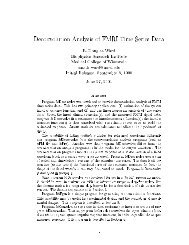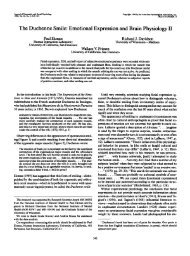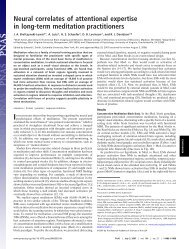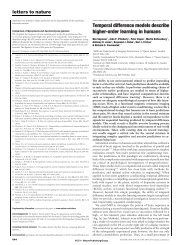l1-magic : Recovery of Sparse Signals via Convex Programming
l1-magic : Recovery of Sparse Signals via Convex Programming
l1-magic : Recovery of Sparse Signals via Convex Programming
You also want an ePaper? Increase the reach of your titles
YUMPU automatically turns print PDFs into web optimized ePapers that Google loves.
finds the vector x ∈ R N such that the error y − Ax has minimum l 1 norm (i.e. we are<br />
asking that the difference between Ax and y be sparse). This program arises in the context<br />
<strong>of</strong> channel coding [8].<br />
Suppose we have a channel code that produces a codeword c = Ax for a message x. The<br />
message travels over the channel, and has an unknown number <strong>of</strong> its entries corrupted.<br />
The decoder observes y = c + e, where e is the corruption. If e is sparse enough, then the<br />
decoder can use (P A ) to recover x exactly. Again, (P A ) can be recast as an LP.<br />
• Min-l 1 with quadratic constraints. This program finds the vector with minimum l 1<br />
norm that comes close to explaining the observations:<br />
(P 2 ) min ‖x‖ 1 subject to ‖Ax − b‖ 2 ≤ ɛ,<br />
where ɛ is a user specified parameter. As shown in [5], if a sufficiently sparse x 0 exists such<br />
that b = Ax 0 + e, for some small error term ‖e‖ 2 ≤ ɛ, then the solution x ⋆ 2 to (P 2 ) will be<br />
close to x 0 . That is, ‖x ⋆ 2 − x 0 ‖ 2 ≤ C · ɛ, where C is a small constant. (P 2 ) can be recast<br />
as a SOCP.<br />
• Min-l 1 with bounded residual correlation. Also referred to as the Dantzig Selector,<br />
the program<br />
(P D ) min ‖x‖ 1 subject to ‖A ∗ (Ax − b)‖ ∞ ≤ γ,<br />
where γ is a user specified parameter, relaxes the equality constraints <strong>of</strong> (P 1 ) in a different<br />
way. (P D ) requires that the residual Ax − b <strong>of</strong> a candidate vector x not be too correlated<br />
with any <strong>of</strong> the columns <strong>of</strong> A (the product A ∗ (Ax−b) measures each <strong>of</strong> these correlations).<br />
If b = Ax 0 +e, where e i ∼ N (0, σ 2 ), then the solution x ⋆ D to (P D) has near-optimal minimax<br />
risk:<br />
E‖x ⋆ D − x 0 ‖ 2 2 ≤ C(log N) · ∑<br />
min(x 0 (i) 2 , σ 2 ),<br />
(see [7] for details). For real-valued x, A, b, (P D ) can again be recast as an LP; in the<br />
complex case, there is an equivalent SOCP.<br />
It is also true that when x, A, b are complex, the programs (P 1 ), (P A ), (P D ) can be written as<br />
SOCPs, but we will not pursue this here.<br />
If the underlying signal is a 2D image, an alternate recovery model is that the gradient is<br />
sparse [18]. Let x ij denote the pixel in the ith row and j column <strong>of</strong> an n × n image x, and define<br />
the operators<br />
and<br />
D h;ij x =<br />
{<br />
x i+1,j − x ij i < n<br />
0 i = n<br />
D ij x =<br />
i<br />
D v;ij x =<br />
(<br />
Dh;ij x<br />
D v;ij x<br />
{<br />
x i,j+1 − x ij j < n<br />
0 j = n ,<br />
)<br />
. (1)<br />
The 2-vector D ij x can be interpreted as a kind <strong>of</strong> discrete gradient <strong>of</strong> the digital image x. The<br />
total variation <strong>of</strong> x is simply the sum <strong>of</strong> the magnitudes <strong>of</strong> this discrete gradient at every point:<br />
TV(x) := ∑ √<br />
(D h;ij x) 2 + (D v;ij x) 2 = ∑ ‖D ij x‖ 2 .<br />
ij<br />
ij<br />
With these definitions, we have three programs for image recovery, each <strong>of</strong> which can be recast<br />
as a SOCP:<br />
2




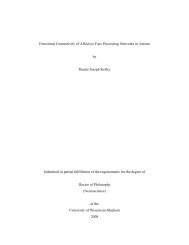
![[F-18]-L-DOPA PET scan shows loss of dopaminergic neurons](https://img.yumpu.com/41721684/1/190x146/f-18-l-dopa-pet-scan-shows-loss-of-dopaminergic-neurons.jpg?quality=85)
